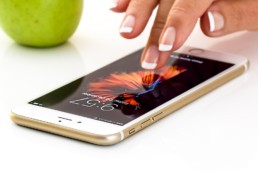
But with the rapid rise in cellphone usage comes increased exposure to radiation. There is also a growing concern that cellphones may even cause cancer.
It’s important to consider the dangers of cellphone radiation and how it impacts human health. Here’s what you should know:
Does Cellphone Radiation Cause Cancer?
While the International Agency for Research on Cancer classifies cellphones as “possibly carcinogenic to humans,” organizations like the World Health Organization (WHO) do not link cellphone usage to cancer officially.
According to the WHO, there is a lack of consistent evidence that supports the notion that cellphones and cellphone usage increases your chances of getting cancer, including brain cancer or head tumors.
The WHO oversaw numerous large studies dating back over 20 years studying the link between cancer and cellphones. However, the organization has yet to discover any substantial evidence to support the potential health risk that pins cellphones as an underlying cause of cancer.
The data from the WHO’s study also revealed that the placement of the phone on certain parts of your body likely won’t lead to increasing your chances of getting cancer, either.
In one study, the WHO examined over 350,000 cellphone users to see if there was an increase in cancer cells where the phone was used, such as a rise in cancer cells that cause brain tumors. However, the study revealed that no evidence linked cellphone usage to health issues, even among participants who have been using their cellphones for at least 10 years.
Yet, professional organizations, such as the IEEE Standards Association and the International Commission of Non-Ionizing Radiation Protection (ICNIRP), provide guidelines for safety limits to exposure to radiation based on available science-backed data, including radiation emitted from cellphones. The guidelines typically recommend limiting exposure up to 300 gigahertz (GHz).
The Scary Science Of Cellphone Radiation
Two forms of radiation categories exist: ionizing radiation and non-ionizing radiation.
Devices, such as cosmic rays, gamma rays and X-rays, emit ionizing radiation. Ionizing radiation emits a very high frequency that can cause ionization in your body and is strong enough to break chemical bonds.
Ionizing radiation is linked to an increase in cancer risk. That is why getting an X-ray at your local dentist’s office often requires that you wear a protective cover over certain parts of your body to avoid overexposure.
However, experts still debate cellphones’ capabilities to cause cancer. Cellphones do emit radiofrequency radiation or radio waves. That’s because the antenna in your cellphone helps create this non-ionizing radiation. Thus, any part of your body that is close to the antenna can absorb this energy. Other non-ionizing devices include ovens, microwave ovens, and radars.
While cellphones radiation isn’t as strong as the radiation from X-rays, it still has biological effects. For instance, devices like cellphones and microwaves can cause heat. That’s part of why you may notice your phone heating your face if you use it for long periods.
Moreover, research shows that cellphone radiation emission can have adverse effects on facial nerves and salivary glands. For instance, a study from the Journal of Clinical Diagnostic Research linked cellphone usage to the change of the flow rate of saliva.
Do Cellphones Damage DNA?
Research also links cellphones to damaging your DNA.
A PLOS One study found that the UMTS signal used in mobile phones induce transient DNA damage.
So, while cellphone usage does not damage all types of DNA, it has the potential to damage some DNA cell lines.
How to Protect Yourself From Cellphone Radiation
While there is still a lack of empirical evidence linking mobile phone usage directly to causing cancer, it’s best to lean cautious, and protect yourself from cellphone radiation.
Consider limiting your use of your mobile phone. Also, use the speakerphone when you can or try to use the phone away from your body.
You can also invest in cellphone cases to help redirect the non-ionizing radiation to a different area or reduce it.
Consider turning off the Wi-Fi feature and data if you’re not using the phone as well. Moreover, using airplane mode also limits radiation emission from your cellphone.
Limit how often you make calls from your mobile phone each day, week and month. It’s also a good idea to limit how long you stay on the phone, too.
It’s important to know that your mobile phone must emit more power and radiation when you are in a rural area or a place with little cellphone reception. So, it’s best to use your mobile phone when you are in an area with good reception.
Is Cellphone Radiation Dangerous? Final Thoughts
With the prevalence of cellphone usage and an increase in cellphone radiation exposure, exploring the possible dangers surrounding cellphone radiation has its benefits.
It’s also worthwhile to take precautionary measures to limit your cellphone usage when you can, especially because the debate still lingers on due to a lack of solid support to link cellphones to cancer.
Just follow these best practices, and you can limit your radiation exposure.
What’s Next?
About the author

